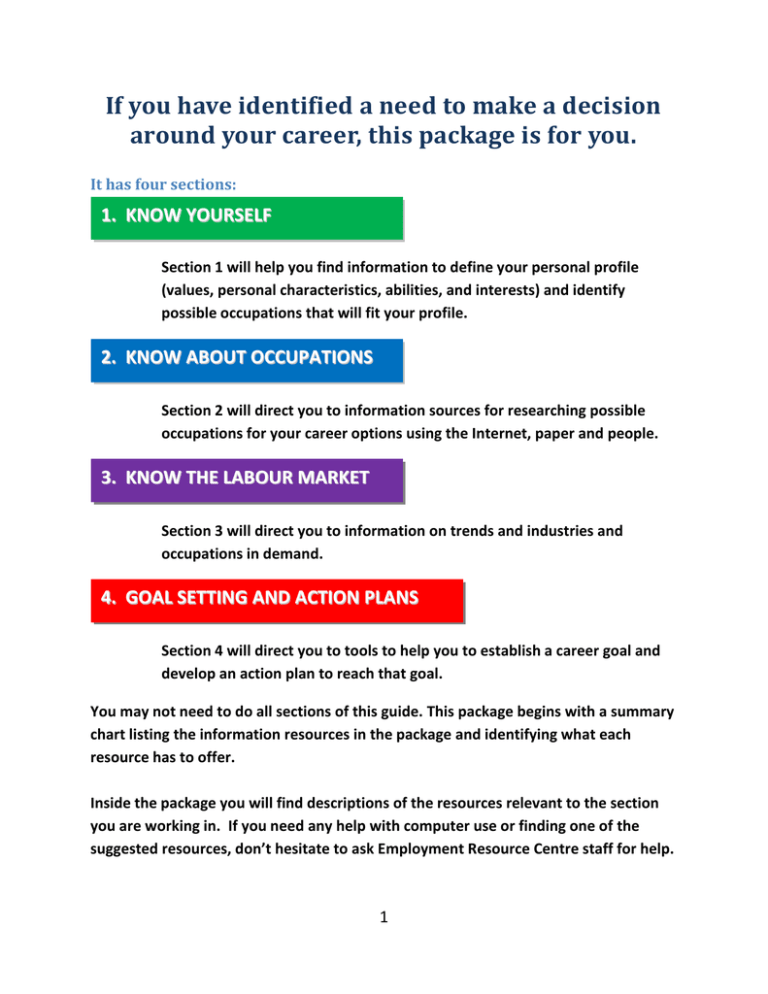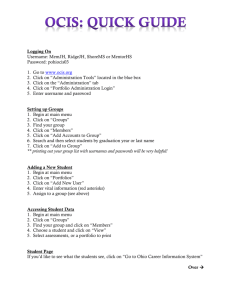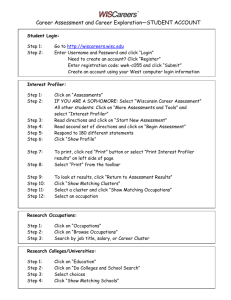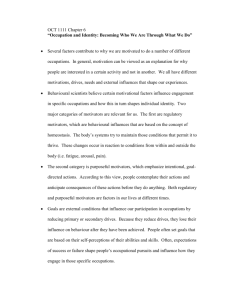1-Career -Decision-making -LMI-CLIENT -PACKAGE-2010-04
advertisement

If you have identified a need to make a decision around your career, this package is for you. It has four sections: 1. KNOW YOURSELF Section 1 will help you find information to define your personal profile (values, personal characteristics, abilities, and interests) and identify possible occupations that will fit your profile. 2. KNOW ABOUT OCCUPATIONS Section 2 will direct you to information sources for researching possible occupations for your career options using the Internet, paper and people. 3. KNOW THE LABOUR MARKET Section 3 will direct you to information on trends and industries and occupations in demand. 4. GOAL SETTING AND ACTION PLANS Section 4 will direct you to tools to help you to establish a career goal and develop an action plan to reach that goal. You may not need to do all sections of this guide. This package begins with a summary chart listing the information resources in the package and identifying what each resource has to offer. Inside the package you will find descriptions of the resources relevant to the section you are working in. If you need any help with computer use or finding one of the suggested resources, don’t hesitate to ask Employment Resource Centre staff for help. 1 SUMMARY OF CAREER DECISION-MAKING LMI RESOURCES TITLE AND LOCATION Personal Assessm ents Career Cruising www.careercruising.com Job Bank www.jobbank.gc.ca www.labourmarketinformati on.ca Saskjobfutures www.saskjobfutures.ca New Brunswick Labour Market Information www.gnb.ca/0126/indexe.asp ALIS Alberta http://alis.alberta.ca Career Development eManual University of Waterloo www.cdm.uwaterloo.ca National Occupational Classification System www5.hrsdc.gc.ca CanLearn www.canlearn.ca Job Futures www.jobfutures.ca Local Education Institutions Resource Centre Binder Lists of Occupa tions Occupational Descriptions & Training Requirements Videos of Real workers Wages List of provincial education institutions Learning / training locations Labour Market Info or Trends Graduate Surveys Action Plan Info Inter viewing 2 1. KNOW YOURSELF This section will help you find information to develop a personal profile that can help you select occupations or jobs that could suit you. There are many websites and paper products that have quizzes to identify values, personal characteristics, abilities, learning styles and interests. Often the websites will also provide lists of occupations that suit different profiles. Here are two recommended sites to get started: www.jobbank.gc.ca – when the “Home Page” opens, scroll down to “Career Navigator” and click on it. These are the choices: o Abilities Quiz: Identify your abilities and get a list of matching occupations to explore o Data, People, Things Quiz: Select the ways you like to work with data, people and things and get a list of matching occupations to explore. o Work Preference Quiz: Do you prefer directive, social, methodical, objective or innovative work? Complete the work preference inventory to get a list of occupations that match your preferences. www.careercruising.com – your resource centre staff will have a handout for you on how to get into this site. From the “Welcome Page,” select “Explore Assessments” in the left menu and then choose to do any or all of the choices: o “Career Matchmaker,” answer questions about your likes and dislikes to find careers that match up with your interests; o “My Skills,” rate your level of skill in 45 key areas to see how your skills match up with the careers that you are interested in; and o “Learning Inventory,” discover how you learn and retain information and find tips on how to improve your study habits to suit your learning style. 3 1. KNOW YOURSELF o “Multiple Intelligence Quiz”: Discover your unique style of thinking and understanding. o “Work Values Quiz”: What values are important to you in your work environment? o “Seeing, Hearing, and Doing Quiz”: Discover your unique style of learning. Ask the Resource Centre Staff for: the Personal Profile Quizzes handout, page 3-8, from the Career Decision-making Binder, or other books or resources to help you develop your personal profile. 4 2. KNOW ABOUT OCCUPATIONS There are excellent resources for learning about occupations. Here are some resources that can guide you to: a. Gather information from electronic and print materials; b. Gather information from people through information interviews. Where I Can Look What I can look for Career Cruising Occupational profiles with job description, www.careercruising.com to see and work conditions, earnings, hear real people on the job education/training, career paths, related jobs, links to other resources (Ask a staff person how to get into 900 interviews with real people in the this site) occupations Education and apprenticeship information Search for an occupation based on your profile www.labourmarketinformation.ca Occupation descriptions to find occupational profiles and Work conditions occupational information specific to Education or training needed each province and region in Canada. General wages If you live in New Brunswick you Employment trends and outlooks can find relevant information on Employers who hire – note that some on occupations for your province on the list are outdated (check with Resource this website. Centre staff) About the Local Labour Market (choose the Labour Market Bulletin) Sask Job Futures Profiles of occupations relevant to your www.saskjobfutures.ca for province information on occupations and Create comparison charts of occupations future opportunities in with salary, numbers employed and job Saskatchewan. Saskatchewan prospects residents can also find provincial Choose to see occupations grouped by occupational information on the education level required for the job labourmarketinformation.ca site above. 5 2. KNOW ABOUT OCCUPATIONS ALIS Alberta http://alis.alberta.ca Talking to Employers – go to the “Career Explorers” section (3rd tab across top), choose “Career Planning Resources” and then “CAREERinsite” In CAREERsite, go to “Career Planning Steps” and you will find “Talking to Employers” about occupations in Step 4 Ask in the Resource Centre for any of these handouts: Where to Go for What you Want, page 9 (more career websites with notes on the content of each) Job Futures Occupations List, page 13 (lists of occupations by interest in People, things and information) Occupations Related to Interests, page 21 (maps of occupations related to interest and ability) Sector Matrices, page 37 (organization chart of occupations in several industries) Information Interview, page 65 (information on how to prepare for and conduct an information interview to get information on occupations of interest) 6 3. KNOW ABOUT THE LABOUR MARKET For information about industry, occupation and hiring trends in the labour market see some of the resources below. You may want to look at some publications and websites like: Labour Market Information Site www.labourmarketinformation.ca has labour market information by province and region within the province. Find prospects for work opportunities and descriptions of trends developing in occupations and industries. New Brunswick Labour Market Information www.gnb.ca/0126/index-e.asp has labour market trends and challenges, information on industries, occupational prospects with some wage information, the wage survey, and graduate surveys from the New Brunswick Community College. The government’s Labour Market Bulletin in the resource centre (you can also print it from the labour market information website mentioned in the first bullet). Look for companies that are expanding, closing or opening for clues on occupation and industry work opportunities. Your local newspaper in the employment resource centre or library. Look in the Business section or other sections for articles about companies, occupations and training. There may be clues about industries that are growing, who may be hiring, jobs that are needed and occupations or industries that are shrinking or disappearing. Sector Councils: Industries (sometimes called Sectors) in Canada have councils and websites with information about their industry. You can find occupational information, industry trends and education and training information on their websites. 7 Ask the resource centre staff for the handout: Where to Go for What you Want, page 9, for the web address and notes on the content of several sector council’s with career websites. List of Canada’s Sector Councils, page 59, with websites and contact information. Information Interview, page 65, has information on how to prepare for and conduct an information interview: a valuable use of information interviewing is to find out local labour market information from employers and employees. Job Futures Employment Prospects Ratings, page 71, will explain what good, fair and poor ratings for work prospects mean. 8 4. GOAL SETTING AND ACTION PLANS You will find resources for creating an action plan for your career goal in the Resource Centre. One resource is the internet site below. The Career Planning Guide on this site is suitable for everyone, no matter what province they live in. ALIS Alberta, http://alis.alberta.ca/ go to the “Career Explorers” section (3rd tab across top), choose view “CAREERinsite.” From this page choose “Taking Action.” Scroll down the page to the “Activities” heading and choose “How to set up an action plan.” This will take you to a printable page for creating your own action plan. Or you may prefer to ask the resource centre staff for the Career Decision-making binder handouts: Setting a Career Goal and Planning Action, page 73 Educational Institutions, New Brunswick page 79; Saskatchewan page 83 (for a goal and action plan that involves education or training) 9





